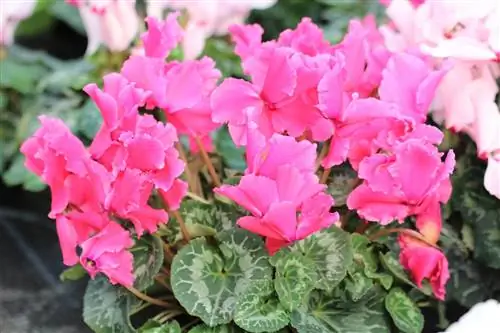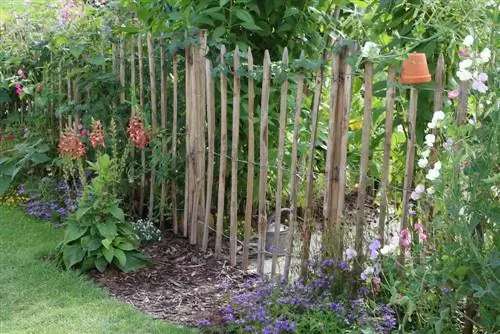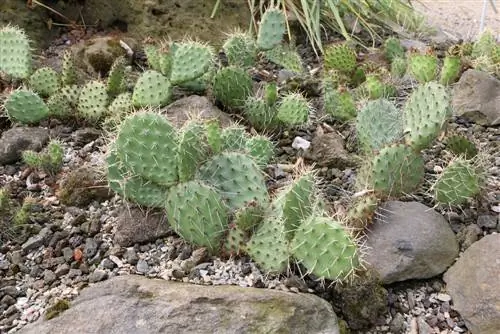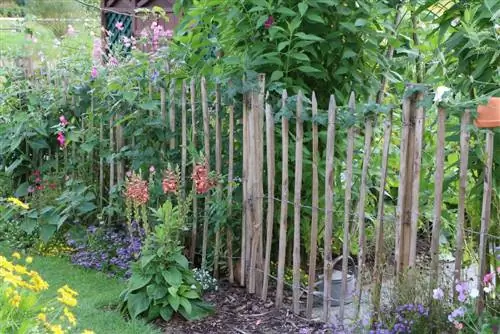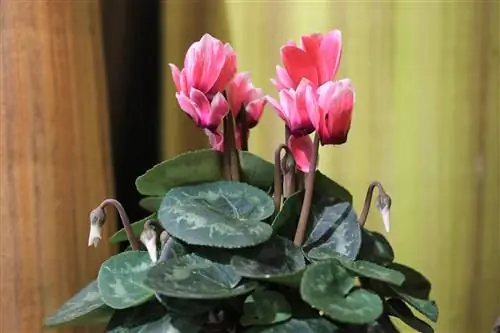- Author admin [email protected].
- Public 2023-12-17 03:39.
- Last modified 2025-06-01 06:48.
Cyclamens come in many different colors. The flowers form individually on stems and are usually mauve, purple or white. All possible variations of pink are also popular. The violets can be purchased both for your own garden and in pots as houseplants. When choosing a location and watering habits, you should consider a few basic requirements.
Cyclamens as houseplants bloom from August to April. When they have finished flowering, you should definitely put the plants outside. Shady places are suitable for this. After the flower buds have formed in autumn, the cyclamen can then “overwinter” indoors again. The leaves usually turn yellow after flowering. For cultivation over several years, watering should be avoided so that leaf growth can be curbed. After removing the yellowed leaves, the plant can be repotted with fresh soil and placed in a bright, cool place.
Demands on the location
- Lighting conditions: bright to partially shaded, no direct sun (sunlight is desirable in winter)
- Water requirement: do not water directly, otherwise tubers and flowers will rot. Allow water to soak over the saucer or pot in the sink
- Temperatures: optimal room temperature between 12 and 16° degrees, in winter 10 - 15° degrees
- Soil requirements: Growing possible in commercial potting soil
- Fertilizer: not shortly after flowering, otherwise weakly concentrated every 2 weeks
Propagate cyclamen
Buller plants are difficult to propagate. Either you can find small nodules on the stem of violets. Or small nodules form at the root end. Depending on the variety of plants, the tubers formed in this way can be used for propagation. Alternatively, you can divide the actual main tuber of the plant into sections, whereby each section should have a shoot bud. The cut surface can be protected from rot with sulfur powder. The individual tubers can then be planted separately.
Growing cyclamen from seeds
Cyclamens look very pretty among ferns, lavender, or sage. Propagation is best done via seeds that are sown in early autumn. The temperatures should still be just above 20 degrees Celsius. There are many winter-hardy varieties, it's best to ask at the nursery. Rarities can also be found on the Internet. Seeds or tubers are often offered on auction platforms or in many online shops.
Repotting
In principle, cyclamen do not necessarily need to be repotted. To renew the potting soil, you should choose a period of time 6-8 weeks after the end of the actual flowering period. When new shoots appear on the tubers, the plant can be repotted into new substrate. The top third should definitely look out of the substrate.
General care instructions
It is essential to remove wilted flowers and yellowed leaves. With the flowers, this can usually be achieved by pulling them out. The stems give way with a slight tug. The same procedure applies to yellowed leaves. This is special, as it otherwise creates a breeding ground for rot, which can quickly spread to the actual tuber.
The cyclamen in the garden
These are usually wild varieties that are hardy due to their origin and usually bloom from September until the first frost. The wild varieties have similar requirements as the already cultivated house plants. In particularly harsh winters, these species should be covered as a precaution. Spruce branches, for example, are suitable for this.
The wild species have special requirements when it comes to soil conditions. In their native environment they usually grow extensively under trees. They don't like direct sunlight, so the north side of a building would be optimal. Above all, you should pay attention to the pH value of the soil. Gardens with a high proportion of coniferous trees have soil that is too acidic, which is caused by fertilization with needles. If necessary, the gardener must improve the soil by adding lime, as the cyclamen prefers alkaline soils.
When it comes to watering, just make sure that the cyclamen does not dry out completely and that it is not supplied with too much moisture. Be sure to avoid waterlogging, as outdoor violets also tend to rot. The moisture can be optimally regulated using a base with bark mulch.
Cyclamens growing outdoors usually reproduce via the fruit stalks. These curl up like a spiral. The ripening fruit capsules are sunk into the ground in this way and continue to ripen there.
A variety of flower colors and flowering times can be achieved through the variety of varieties on offer. For example, there are varieties that show their first flowers in summer and others that bloom from autumn until the first frost. Here the hobby gardener should seek advice from a specialist in order to know the requirements of the plants and the results to be expected. Cyclamen are relatively easy to care for, especially as houseplants, and are also ideal for locations without direct sunlight. Due to the recommended temperatures, a bedroom on the north side, for example, would be an option. You can avoid regular watering if you place the pot in a water bath once a week so that the ball can soak up.
Cyclamen care in brief
- Cyclamens may only be watered over their saucers. Always make sure that the flowers and leaves do not get any water, otherwise there is a risk of rot.
- You need fertilizer every 14 days during the growth and flowering phase.
- In spring the leaves begin to turn yellow. This is a clear sign of their rest period. At this time you also stop fertilizing and watering is also reduced to the bare minimum.
- Remove everything that has faded and yellowed completely so that it cannot provide a breeding ground for infections.
- During the summer, cyclamens are welcome to go out into the fresh air, but make sure that they are protected from sun and rain. The sensitive tubers must not wither.
- Towards the end of August is the best time to repot the cyclamen. Make sure that the upper third of the nodules are not completely covered with soil. As soon as fresh shoots appear, you can water more frequently and start fertilizing again.

